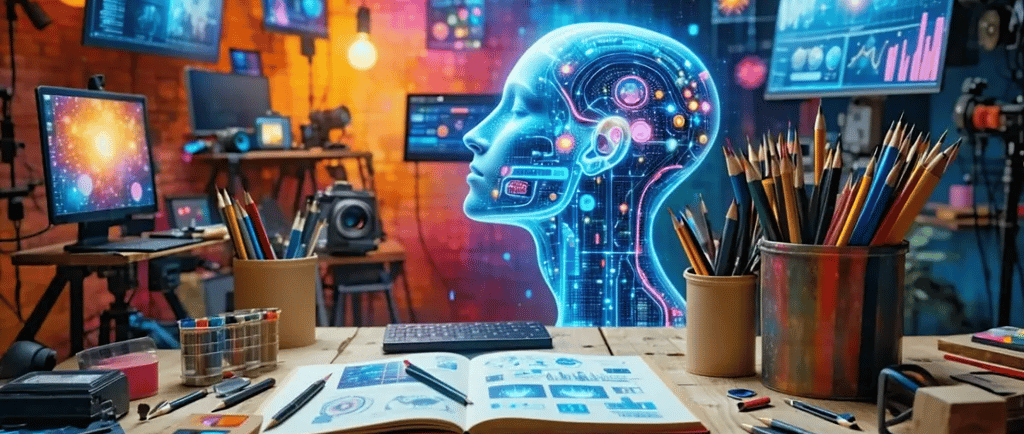When Machines Learn to Tell Stories: How AI Is Poised to Transform Australian Content Creation by 2025
New forecasts suggest that by 2025 AI will not only accelerate content production in Australia, but reshape who creates, how value is judged, and what it means to build trust in a saturated media environment.
CREATORS


On one level it sounds like a simple projection: more content, faster turnaround, tools to ease workloads. But on another level, what is coming for Australia’s creator economy is nothing short of a transformation in the very grammar of storytelling. AI is already reconfiguring authorship, voice, and attention. By 2025 it may well redraw the ground on which creators stand.
If you build brands, produce media, lead creative teams, or nurture audiences, it is time to look not just ahead — but inward. The shift is already under way.
Australia’s Creators See the Turning Tide
A recent forecast, Fujifilm Forecast: Content Creation Trends for 2025, reveals that 34 percent of Australian creators believe AI will significantly reshape how content is produced and consumed in the near future. IT Brief Australia Nearly three in ten (27 percent) anticipate the rise of virtual influencers and AI personas as meaningful trend lines. IT Brief Australia
The sentiment is both hopeful and cautious. While 28 percent say AI has the potential to enhance originality and quality, a sizable number raise alarms about misinformation or eroding human authenticity. IT Brief Australia What’s clear is that the debate is no longer about whether AI will change content — it is about how much control creators will retain.
International analysis confirms this tension. Scholars who study generative AI across text, image, and audio domains see progress accelerating across creative industries. But they warn that AI’s strength lies in scale, not in nuance, and that human oversight remains indispensable. arXiv+1
Three Shifts We’ll See by 2025
1. Volume with Tiered Value
AI will enable creators and brands to produce a flood of content: blogs, social posts, audio clips, video cuts, localized versions of content. Because the marginal cost of creating derivative variants or micro-content falls drastically, supply will become overwhelming. But not all content holds value. What will separate value is difference — voice, insight, domain authority, perspective.
Already, content platforms are exploring AI-generated metadata (titles, tags, summaries). In one large field experiment, applying AI-generated titles to user-generated videos boosted watch time by 1.6 percent overall — and up to 7.1 percent when users revised and refined those titles themselves. arXiv This suggests the combination of AI scale and human curation will carry premium return.
2. Discovery & Trust Become Strategic Fronts
As AI becomes a gatekeeper layer atop information (summarisation, recommendation, filtering), the question of visibility changes. It is no longer just about SEO or social reach. It becomes about how algorithms interpret, summarise, and surface authority. In Australia, analysts are already witnessing changes in how brand visibility is shaped in AI models. For instance the 2025 LEO Insights Report argues that AI platforms now rely heavily on third-party credibility signals (media coverage, expert citations) to evaluate brand claims — and that owned content may be deprioritised. CFOtech Australia
Trust, authenticity, consistency, reputation and explanatory context become essential. If AI trims away nuance in search or answers, what remains — what is cited, what is trusted — becomes the battleground.
3. Role Shifts: From Writer to Orchestrator
By 2025 many creators will see their role evolve: less as sole originator, more as curator, trainer, editor, choreographer of human + machine collaboration. AI may draft first drafts, propose angles, automate repetitive formatting, produce translated scripts or visual variants. The highest value tasks will remain ideation, framing, strategy, voice, narrative control, domain insight — but those will be overlaid with machine support.
In media and creative fields, AI is already entering post-production pipelines (image clean up, automated editing, sound mixing) in a low-friction way. arXiv Over time that extends into draft shaping itself — but always under human guardrails.
Risks, Friction, and Battlegrounds
This transition is not frictionless. Some of the key tensions:
Authenticity vs Generic Output. When too much content sounds alike, audiences fatigue. AI homogenization of tone risks eroding engagement.
Intellectual Property & Attribution. Who owns AI-assisted content? What claims of originality can creators legitimately make?
Misinformation & Quality Control. AI systems can hallucinate or misinterpret. Without oversight, errors may slip into public view.
Access and Equity. Larger players with capital will likely access premium AI models. Smaller creators may be left with weaker tools or dependency.
Algorithmic Bias & Opaqueness. If AI summarisation or recommendation systems are opaque, creators lose visibility control.
A Call to Creators, Brands, and Institutions
At TMFS, we believe that when technology changes the landscape, creators who adapt not by chasing the wave but by shaping its form emerge strongest. Here are ways to stay ahead:
Build signal infrastructure, not just content. Cultivate independent media references, expert voices, authentic networks that AI can cite.
Design with co-creation in mind. Assume AI will be part of your process. Train, adapt, reject, refine.
Lean into human difference. Emotional resonance, vulnerability, culture, deep insight — these remain the fault lines where AI cannot wholly compete.
Monitor and govern. Be vigilant about AI output, attribution, and error. Own the guardrails of your brand.
As AI becomes a full participant in our content economy by 2025, the question is not whether creation changes — it already is changing — but whether you lead or lag that change. TMFS will continue to track, interpret, and guide through the turning tides.
All rights belong to their respective owners. This article contains references and insights based on publicly available information and sources. We do not claim ownership over any third-party content mentioned.


